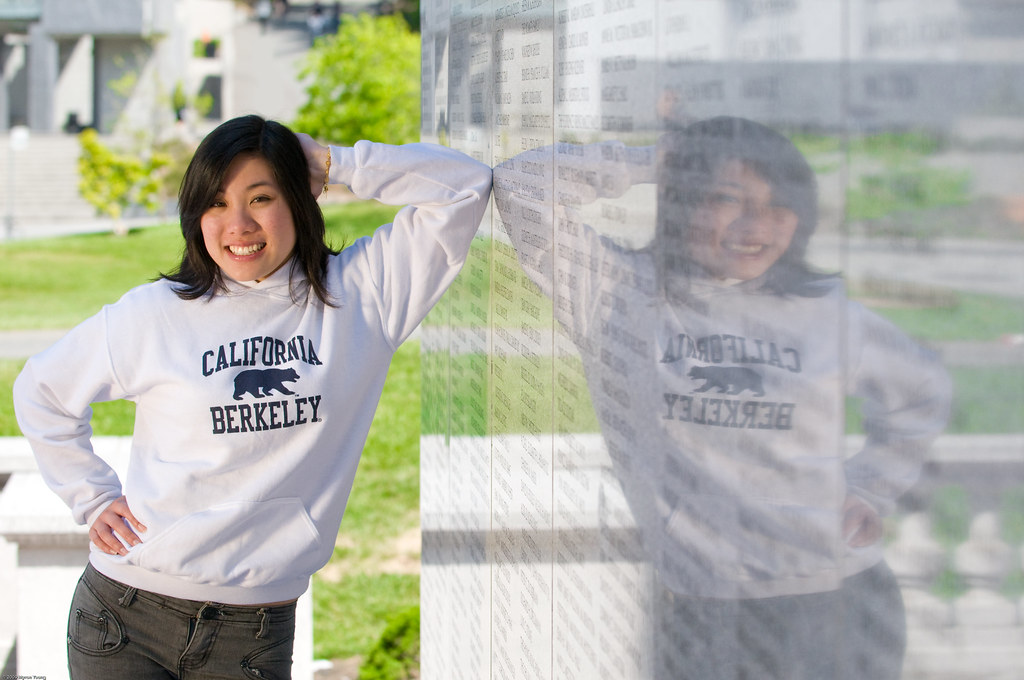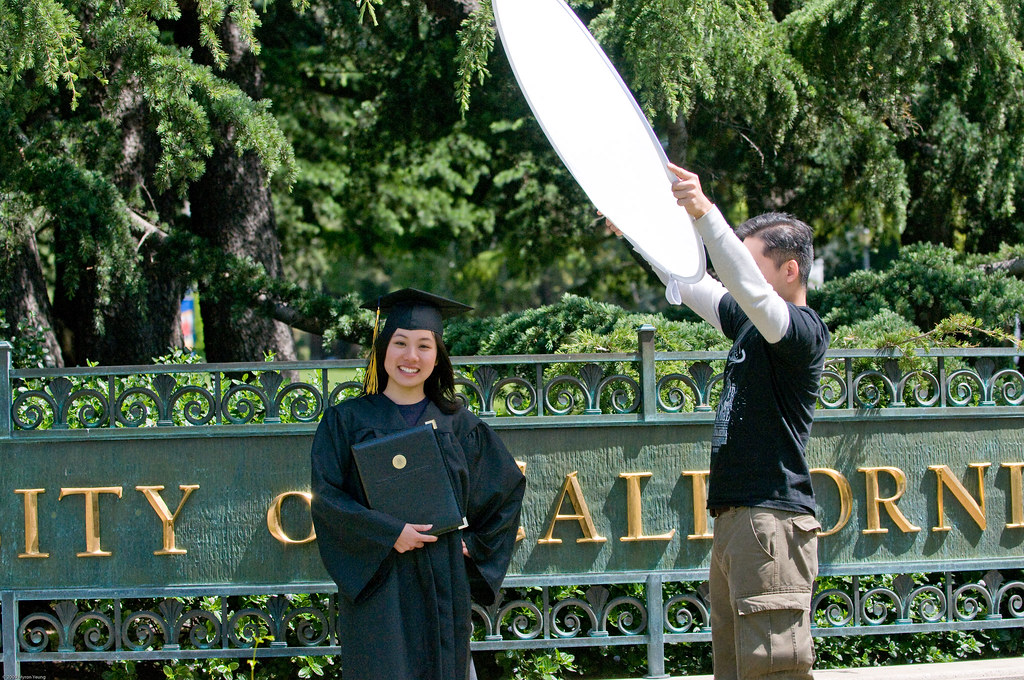
I love the sun, but when it comes to photography, it sometimes isn't my best friend. Portraits don't look as nice when the sun is high and the skies are clear, because the sun casts harsh shadows and your subjects will squint. There are many ways to mitigate this as I've discussed
before. For this shoot, I tried #4, which in short says "bring the shade to your subjects, e.g. with a collapsible translucent disc.
My buddy and I shot his cousin's graduation portraits at my alma mater U.C. Berkeley (Go Bears!). It's a lovely campus, but the sun was blazing down on us. You can really see the difference between shooting her under the open sky and shooting her in the shade. Compare for yourself:
Unshaded:
 Shaded:
Shaded:

Yes, yes, I know there are a bunch of other differences between the shots like her location, her cap, etc. But notice how in the shade her eyes are less squinty and that the light on her face is more flattering.
Here's a shot of the disc in action. Brian and I took turns holding the disc and let me tell you, it can really strain the shoulders after awhile!

If you don't have a disc, you can move your subjects under a tree, next to the shady side of a building, or any location that will shield your subjects from direct sunlight.
You can see the rest of the photos from the shoot
here.
 I don't like shooting indoors with on-camera flash, because the light flattens faces and can cast some ugly shadows. The advantage of on-camera flash however, is that you are very mobile. But what if you take your flash off your camera, remotely control the firing of it from your camera, and aim it at the ceiling? Now you always have a diffuse source of light as long as you shoot in the room.
I employed this technique at my buddy Mark's son's Red Egg and Ginger Party. As you can see in the photo below, my setup was a lot simpler than the two-light strategy I employed last December. I got lucky this time, because the ceiling was very high, so the light from the flash was able to spread out before bouncing back towards the subjects.
I don't like shooting indoors with on-camera flash, because the light flattens faces and can cast some ugly shadows. The advantage of on-camera flash however, is that you are very mobile. But what if you take your flash off your camera, remotely control the firing of it from your camera, and aim it at the ceiling? Now you always have a diffuse source of light as long as you shoot in the room.
I employed this technique at my buddy Mark's son's Red Egg and Ginger Party. As you can see in the photo below, my setup was a lot simpler than the two-light strategy I employed last December. I got lucky this time, because the ceiling was very high, so the light from the flash was able to spread out before bouncing back towards the subjects.
 How did I do this?
1. I connected the flash to a mini tripod and placed them on a shelf at one end of the room.
2. I aimed the flash at the ceiling.
3. I connected the flash to a radio receiver.
4. I set the flash to manual mode and dialed the power to around 1/4.
5. I connected a radio transmitter to the hot shoe of the camera. Whenever I released the shutter, the transmitter told the flash to fire.
6. Started shooting! Because the flash was set to manual mode, it was easy to modify the power to ensure that my subjects were neither over nor underexposed.
There are a few things to be aware of:
1. Watch out for hot spots. The closer your subject is to the actual flash, the brighter and overblown they will turn out.
2. Avoid shooting subjects in darker areas of the room (unless you like the effect).
So do you need expensive fancy equipment to do this? Not really. If you have a flash with a built-in optical slave, you're ready to go. An optical slave detects when a flash is fired and in turn tells itself to fire. Use the built-in flash on your camera to trigger the remote flash. This all happens in mere milliseconds. You can also buy a small optical slave unit that connects to the hot shoe of your flash. Just be careful that your remote flash and your built-in flash don't overexpose your subjects.
If you have a relatively new camera and flash from the same manufacturer (e.g. Nikon or Canon), you can use their out-of-the-box remote flash trigger solutions.
Give it a try, it's liberating!
You can see the rest of the photos from the party here.
How did I do this?
1. I connected the flash to a mini tripod and placed them on a shelf at one end of the room.
2. I aimed the flash at the ceiling.
3. I connected the flash to a radio receiver.
4. I set the flash to manual mode and dialed the power to around 1/4.
5. I connected a radio transmitter to the hot shoe of the camera. Whenever I released the shutter, the transmitter told the flash to fire.
6. Started shooting! Because the flash was set to manual mode, it was easy to modify the power to ensure that my subjects were neither over nor underexposed.
There are a few things to be aware of:
1. Watch out for hot spots. The closer your subject is to the actual flash, the brighter and overblown they will turn out.
2. Avoid shooting subjects in darker areas of the room (unless you like the effect).
So do you need expensive fancy equipment to do this? Not really. If you have a flash with a built-in optical slave, you're ready to go. An optical slave detects when a flash is fired and in turn tells itself to fire. Use the built-in flash on your camera to trigger the remote flash. This all happens in mere milliseconds. You can also buy a small optical slave unit that connects to the hot shoe of your flash. Just be careful that your remote flash and your built-in flash don't overexpose your subjects.
If you have a relatively new camera and flash from the same manufacturer (e.g. Nikon or Canon), you can use their out-of-the-box remote flash trigger solutions.
Give it a try, it's liberating!
You can see the rest of the photos from the party here.








